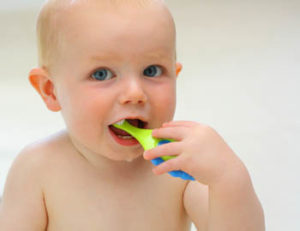Are You Putting Too Much Toothpaste on Your Child’s Toothbrush?
 It is very important to begin attending to your child’s oral health even before teeth appear in their mouth! But, how much toothpaste should you be using? In commercials we see a long strip of toothpaste covering the entire brush head, but studies show this is nowhere close the recommended amount.
It is very important to begin attending to your child’s oral health even before teeth appear in their mouth! But, how much toothpaste should you be using? In commercials we see a long strip of toothpaste covering the entire brush head, but studies show this is nowhere close the recommended amount.
Even before teeth erupt in your infant’s mouth, it is important to rub their gums with a moist gauze pad or cloth in order to help remove any food residue and bacterial biofilms that may be lingering. At approximately 6 months of age, your baby’s first tooth will begin to erupt into their oral cavity. The second the first tooth is exposed, it is vulnerable to decay. This decay can be easily prevented with proper oral hygiene. However, until your child can brush their own teeth, it is important to brush their teeth for them or supervise them brushing with fluoridated toothpaste twice a day.
Fluoride is a mineral that is incorporated into developing teeth to make them stronger and more resistant to decay. Many communities have fluoridated water, but if your family is on well water or you live in a community without fluoridated water, it is important to make sure you are using fluoride toothpaste and rinses for your child. Most bottled water does not contain fluoride, so you only receive these benefits from drinking tap water. Your dentist may even recommend giving your child fluoride chews to help strengthen their teeth. Baby teeth are more susceptible to decay so it is very important to make sure we take care of them. Even though they fall out, the permanent teeth are located so close under them that any decay on baby teeth could easily be transferred to permanent teeth.
 So, does this mean we should be using a huge glob of toothpaste to make sure our infants are fully protected from decay? Absolutely not. Infants and toddlers have not fully developed their ability to spit. The American Dental Association recommends using a smear of fluoridated toothpaste for children under the age of 3, and a pea-sized amount for ages 3-6 (see image). Always supervise your child while they brush until you feel completely confident they are able to successfully do this on their own.
So, does this mean we should be using a huge glob of toothpaste to make sure our infants are fully protected from decay? Absolutely not. Infants and toddlers have not fully developed their ability to spit. The American Dental Association recommends using a smear of fluoridated toothpaste for children under the age of 3, and a pea-sized amount for ages 3-6 (see image). Always supervise your child while they brush until you feel completely confident they are able to successfully do this on their own.
References:
https://www.mouthhealthy.org/en/babies-and-kids/moms-guide-to-fluoride
https://www.mouthhealthy.org/en/babies-and-kids/healthy-habits

